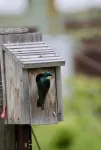(Press-News.org) Maximum temperature extremes reduce the nesting success of birds across the United States by nearly 50% in agricultural landscapes but not forests, according to a new study based on more than 20 years of citizen-science nest-monitoring data. The findings show that future warming may exacerbate the negative effects of habitat conversion on bird fitness, especially among species of conservation concern in human-dominated landscapes. Habitat conversion and climate change are fundamental drivers of biodiversity loss worldwide. However, the effects of each are often analyzed in isolation, despite the understanding that the fate of many species will ultimately depend on how these dual stresses interact. By removing insulating tree canopies or other complex microhabitats, many forms of habitat conversion (e.g., agricultural expansion) can expose species to more pronounced climate extremes. For example, agricultural landscapes regularly reach temperatures more than 10 degrees Celsius higher than in nearby natural habitats. As a result, agricultural and other human-dominated landscapes may become less hospitable for species, including habitat generalist birds, who are particularly sensitive to temperature extremes. Despite this, the interactive effects of climate and land-use change aren’t fully understood. Using data from Project NestWatch – a citizen-science nest-monitoring program – Katherine Lauck and colleagues examined how extreme heat influences birds’ fledgling success in different land-use types within the continental U.S. Lauck et al. analyzed 152,863 nesting attempts by 58 bird species across 23 years at sites in forests, grasslands, agricultural settings, and developed areas. They compared nest success to temperature extremes recorded for each region, during each attempt. They report that the probability of a nest successfully fledging at least one young bird declined by 46% during extreme warm temperature anomalies in agricultural settings. In contrast, extreme heat increased the reproductive success of birds in forested areas by 14% during extreme warm temperatures, perhaps due to cooling from the forest canopy or a reduced need for thermoregulatory care. Importantly, Lauck et al. note, however, that this positive relationship does not suggest that climate change is an overall benefit to forest birds, overall. The findings also show that birds that build exposed cup nests and species of higher conservation concern, like the oak titmouse or chestnut-backed chickadee, for example, were particularly vulnerable to heat extremes in agricultural landscapes.
END
Agricultural landscapes and heat erode nest successes of birds across the United States
2023-10-19
ELSE PRESS RELEASES FROM THIS DATE:
Observations from a bright fast radio burst probe the distant universe
2023-10-19
An unusually high-energy fast radio burst (FRB) from a high-redshift galaxy has offered new insights into the distant universe, challenging current models of FRB emission. The findings also help constrain key attributes of these astrophysical phenomena. FRBs are brief pulses of radio emission originating from distant extragalactic sources. Although the astrophysical processes that cause FRBs aren’t fully understood, the signals they produce can be used to infer information about the cosmic environments they pass through as they travel across the universe, including the nature of ...
Introducing NorthPole: a brain-inspired chip design that enables low-power AI inference
2023-10-19
Researchers present NorthPole – a brain-inspired chip architecture that blends computation with memory to process data efficiently at low-energy costs. Since its inception, computing has been processor-centric, with memory separated from compute. However, shuttling large amounts of data between memory and compute comes at a high price in terms of both energy consumption and processing bandwidth and speed. This is particularly evident in the case of emerging and advanced real-time artificial intelligence (AI) applications like facial recognition, object detection, and ...
Periodical cicada emergence disrupts food webs, increases plant damage in eastern North American forests
2023-10-19
The periodical mass emergence of cicadas in eastern North American forests can “rewire” forest food webs and initiate a cascade of ecological impacts that propagates throughout the food chain, according to a study that quantified effects of the 2021 Brood X cicada emergence. The study found that when insect-eating birds have abundant prey in the form of cicadas and thus shift their focus away from their usual repast – leaf-eating caterpillars – the caterpillars feast more heavily upon the leaves of oak saplings, doubling insect leaf damage. “Although previous studies have documented strong ecological ...
You say genome editing, I say natural mutation
2023-10-19
For tens of thousands of years, evolution shaped tomatoes through natural mutations. Then, humans came along. For centuries, we’ve bred and cherry-picked tomatoes with our preferred traits. Today, CRISPR genome editing allows us to make new crop mutations that improve traits even further. However, individual mutations, whether natural or engineered, don’t work alone. Each operates in a sea of thousands of so-called “background” mutations. These changes have been sowed by evolution and agricultural ...
Heat waves harm bird reproduction on agricultural lands
2023-10-19
Bird populations are in rapid decline across North America. While climate change is just one of the many factors influencing North American birds, its effects are significant and can interact with other stressors, such as habitat loss. A team of University of California, Davis, researchers found that the effects of extreme temperatures on avian reproduction can vary depending on the type of environment that birds call home.
The findings, published in the journal Science, shed light on how climate change can combine with habitat loss to affect bird reproduction ...
Astronomers detect most distant fast radio burst to date
2023-10-19
An international team has spotted a remote blast of cosmic radio waves lasting less than a millisecond. This 'fast radio burst' (FRB) is the most distant ever detected. Its source was pinned down by the European Southern Observatory’s (ESO) Very Large Telescope (VLT) in a galaxy so far away that its light took eight billion years to reach us. The FRB is also one of the most energetic ever observed; in a tiny fraction of a second it released the equivalent of our Sun’s total emission over 30 years.
The discovery of the burst, named FRB 20220610A, was made in June last year by the ASKAP radio telescope in Australia ...
Imprinted genes in the ‘parenting hub’ of the brain determine if mice are good parents
2023-10-19
Whether a mouse is a good or bad parent can be traced back to imprinted genes in key neurons in the “parenting hub” in the brain, according to a new study by Anthony Isles of Cardiff University and colleagues, published October 19 in the journal PLOS Genetics.
In mice, there is some evidence that an unusual phenomenon in mammals called genomic imprinting impacts parenting behavior. Mammals inherit two copies of each gene – one from each parent – and usually, each copy is expressed equally in the cell. With imprinted genes, however, only one copy is expressed, ...
With smartphone videos, clinicians can analyze human movement using open source "OpenCap" platform, 25x faster and at a fraction of the cost of labs
2023-10-19
With smartphone videos, clinicians can analyze human movement using open source "OpenCap" platform, 25x faster and at a fraction of the cost of labs.
####
Article URL: https://journals.plos.org/ploscompbiol/article?id=10.1371/journal.pcbi.101XXXX
Article Title: OpenCap: Human movement dynamics from smartphone videos
Author Countries: US
Funding: SDU, AF, LK, JM, ASC, JLH, and SLD were supported by the National Institutes of Health (https://www.nih.gov; grant 1P41EB027060-01A1) and the Wu Tsai Human Performance Alliance (https://humanperformancealliance.org). ASC and MK were supported by Philips Healthcare (https://www.usa.philips.com/healthcare) ...
New smartphone app quickly analyzes human motion to aid physical rehabilitation
2023-10-19
WHAT:
A research team funded by the National Institutes of Health has developed a smart phone app that can track and analyze a person’s ability to move from one place to another, known as locomotion, and other types of movements. Human motion analysis is used to evaluate patients with movement difficulties, to help clinicians plan surgery, and to assess the results of treatment procedures. The research team believes that using the app costs about 1% of conventional motion analysis techniques and works 25 times faster. The study appears in PLOS Computational Biology.
Researchers tested their app, called OpenCap, with 100 participants. Using two or more smart phones, ...
BNP peptide a culprit in eczema
2023-10-19
Researchers from North Carolina State University have pinpointed a particular peptide’s role in activating atopic dermatitis, or eczema. The work could lead to more effective treatments for the condition.
Atopic dermatitis (AD) is a skin condition characterized by itching, irritated and thickened skin at the site of the irritation. The brain natriuretic peptide (BNP) is a peptide, or short chain of amino acids, that is elevated in patients with AD.
“BNP is expressed in sensory neurons, the neurons responsible for conveying sensation to the brain via the spinal cord,” ...



